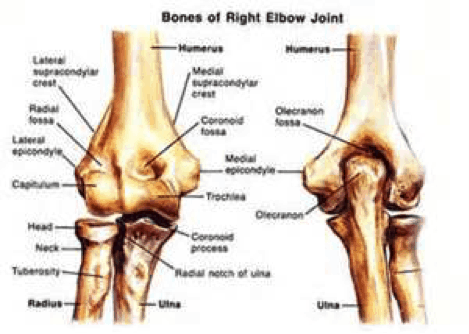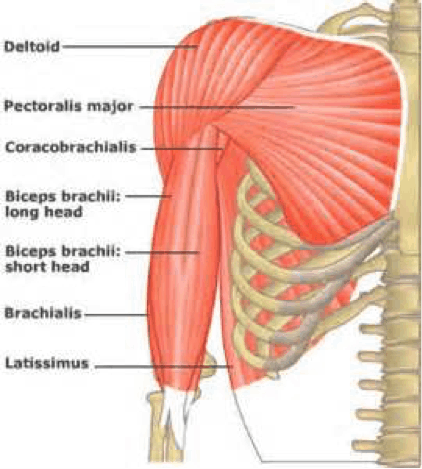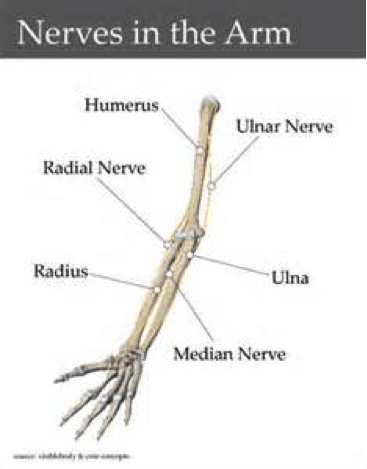
The elbow is a very versatile joint that provides a great deal of motion. Without the elbow, many simple daily activities such as eating, toileting, and getting dressed would be very difficult to perform.
The elbow is a very complex structure that we will review in this article. Read on to learn more about the anatomy of your elbow and the many functions that this joint allows us to perform on a daily basis.
The Bones of The Elbow
 The elbow consists of several bones — each with an important role. The elbow is the connecting point for the radius and ulna to the humerus. A detailed description of these bones follows below:
The elbow consists of several bones — each with an important role. The elbow is the connecting point for the radius and ulna to the humerus. A detailed description of these bones follows below:
Radius – The bone of the forearm that spans the elbow to the wrist. This bone is located on the side of the forearm where the thumb is located.
Ulna – The ulna is a thinner bone that also spans the forearm. At the wrist, it connects with the radius. This bone lies on the side of the arm where the pinkie is located.
Humerus – The humerus is the long bone of the upper arm. This bone helps form the shoulder joint above and the elbow joint below.
Muscles of the Elbow
 Similar to other joints around the body, there are many muscles that help to both stabilize and move the elbow. Without these muscles, many of the actions we perform on a daily basis would be impossible. To keep things simple, there are two major muscle groups of the elbow. These are discussed below.
Similar to other joints around the body, there are many muscles that help to both stabilize and move the elbow. Without these muscles, many of the actions we perform on a daily basis would be impossible. To keep things simple, there are two major muscle groups of the elbow. These are discussed below.
Biceps Brachii – This is a large muscle that is present on the front portion of the upper arm. i.e. the “Popeye” muscle. This muscle helps to rotate the forearm so that our palm is faced upwards. It also a flexor of the elbow (i.e bends the elbow).
Triceps Brachii – This group of three muscles originates at the shoulder and back of the upper arm. It spans the elbow to attach to the ulna bone. This muscle is the primary extender of the elbow (i.e. straightens the elbow).
Nerves of the Elbow
 There are three major nerves that cross the elbow. These nerves control the muscles in the forearm and hand and provide sensation to the forearm/hand as well.
There are three major nerves that cross the elbow. These nerves control the muscles in the forearm and hand and provide sensation to the forearm/hand as well.
Median Nerve – The median nerve crosses the elbow anteriorly (i.e. on the front of the elbow). The median nerve controls the muscles that allow the forearm and hand to flex (bend). It also provides sensation to the thumb, index, and middle fingers. Compression of this nerve at the wrist (a common condition), can cause carpal tunnel syndrome.
Ulnar Nerve – This nerve lies on the inner aspect of the arm. This nerve, along with the median nerve, controls finger and wrist flexion. This nerve mainly provides sensation to the pinky and ring finger. Compression of this nerve can occur at the elbow. This leads to a condition called cubital tunnel syndrome.
Radial Nerve – For the most part, the radial nerve exist on the backside of the forearm. In fact, after crossing the elbow, it splits into two separate branches: the superficial radial nerve, and the posterior interosseous nerve (PIN). The PIN allows for extension of the wrist and fingers (straightening out). The superficial radial nerve provides sensation to the backside of the thumb, index, and middle fingers.
